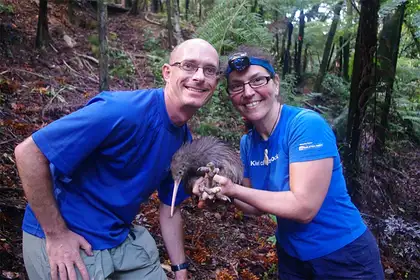
Professor Stephen Marsland and Associate Professor Isabel Castro.
Conservationists have struggled for years to create software capable of identifying bird species through their song alone – new funding is giving Massey scientists the ability to succeed where others have failed.
The project, AviaNZ: Making Sure New Zealand Birds Are Heard, received $880,000 from the Royal Society of New Zealand's annual Marsden Fund to further develop their AviaNZ software, which is designed to detect, recognise, analyse, and ultimately infer bird populations from the estimated 20,000 acoustic recorders deployed around the country.
“If we are to have any chance of achieving goals like 100,000 Kiwi by 2030, and Predator Free New Zealand 2050, we need measurement tools that are efficient and reliable enough to track the populations of our birds and tell us where our actions are best put,” Associate Professor Isabel Castro says.
“The problem is that birds are hard to monitor – they move around, they live in the bush, and they are often well-camouflaged or nocturnal, so estimating how many there are is tough. Fortunately for us, birds are very talkative and by leaving audio recorders in spots, we can identify them through their song.”
The current industry-standard for measuring bird populations relies on people doing direct counts of birds in the field. In New Zealand, researchers use 5-minute call counts, where they count the presence or absence of a small number of birds in 5-minute periods. Recordings are analysed with the help of headset and a program that allows you to see the spectrogram [a visual representation of the sound] and counting the calls of individual species in sections of these recordings.
“The human ear is a powerful recognition tool, but this kind of analysis is subjective, error prone, and slow with only a fraction of the data actually used. When you add in the varied quality of recordings, differences in calls from day to night and locations or competing sounds from the environment – you see the problem.”
“We scientists don’t like uncertainty and we look for better ways. In order for us to estimate populations we don’t actually need to teach computers to recognise birds as good as we do, we need to teach them how to do it better.”
The solution
The researcher’s solution to the mammoth problem is the AviaNZ software, which combines experts in technology and bird ecology/behaviour to solve the problem neither side could alone.
“We’ve got the scope of expertise,” Dr Castro says. “We have mathematics, computer science, signal processing, but we also have expertise about the birds and their behaviour - by combining the technical and ecological work we believe that we are more likely to be successful where others have not by allowing people to see beyond the birds and beyond the sounds’ characteristics.”
The envisaged platform would be able to take audio recordings of varied qualities and have the capability for the researcher to search for specific birds at the touch of a button.
“In the beginning it might come back with four of the birds calls at 100 per cent certainty and 10 that need to be manually checked, but as the system learns and we refine it, it will be more and more accurate.
To achieve this the software needs additional technological solutions and new knowledge of the behavioural ecology of our native species.
Ecological field experiments will be conducted across New Zealand, these will help the researchers to better understand other variables on vocalisations such as the relationship of sex, season and population density on the number of calls of individual birds.
“In just one project we are going to adapt mini-microphone technology to learn about the vocal behaviour of kiwi in order to establish a baseline of average call per bird. We will then feed the data into software to give population estimates on the amount of birds in any one given spot.”
This data can be confirmed using the translocated populations of several species where the researchers know the exact or nearly exact numbers of individuals, e.g. kakapo, kokako, saddlebacks, kiwi, hihi.
While this technology will be developed using New Zealand birds, the technology will be pertinent to other countries with much larger populations of wildlife. It will also be used to inform regional councils and conservation groups as to where recorders should be placed for best results and the protocols for their use.
The team will also look into whether or not it is possible to identify individual birds on the basis of their calls alone, which could allow them to identify when one recorder has picked up the same bird.
The team will be led by Principal Investigator Professor Stephen Marsland. And includes post-doctoral fellow Dr Nirosha Priyadarshani, with other members to be added.
The software will be made publicly available through the AviaNZ software platform.